FINDING UNKNOWN COEFFICIENTS IN CONTINUOUS FUCNTION
Subscribe to our ▶️ YouTube channel 🔴 for the latest videos, updates, and tips.
Subscribe to our ▶️ YouTube channel 🔴 for the latest videos, updates, and tips.
Problem 1 :
Find the value of a if the function is continuous.
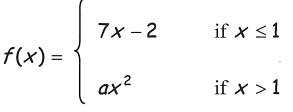
Solution :
Lim x->1- f(x) = Lim x->1- 7x - 2
Applying the limit, we get
Lim x->1- f(x) = 7(1) - 2
= 5 ----(1)
Lim x->1+ f(x) = Lim x->1+ ax2
Applying the limit, we get
Lim x->1+ f(x) = a(1)2
= a----(2)
(1) = (2)
a = 5
Problem 2 :
Find the value of a if the function is continuous.
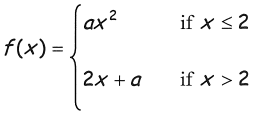
Solution :
Lim x->2- f(x) = Lim x->2- ax2
Applying the limit, we get
Lim x->2- f(x) = a(2)2
= 4a ----(1)
Lim x->2+ f(x) = Lim x->2+ 2x + a
Applying the limit, we get
Lim x->2+ f(x) = 2(2) + a
= 4 + a----(2)
(1) = (2)
4a = 4 + a
4a - a = 4
3a = 4
a = 4/3
Problem 3 :
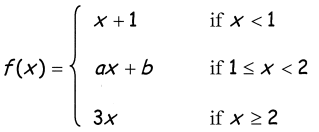
Solution :
lim x->1- f(x) = Lim x->1- x + 1
Applying the limit, we get
Lim x->1- f(x) = 1 + 1
= 2
Lim x->1+ f(x) = Lim x->1+ ax + b
Applying the limit, we get
Lim x->1+ f(x) = a(1) + b
= a + b
Equating left hand limit and right hand limit, we get
a + b = 2 ----(1)
lim x->2- f(x) = Lim x->2- ax + b
Applying the limit, we get
Lim x->2- f(x) = a(2) + b
= 2a + b
Lim x->2+ f(x) = Lim x->2+ 3x
Applying the limit, we get
Lim x->2+ f(x) = 3(2)
= 6
Equating the left hand limit and right hand limit, we get
2a + b = 6 ----(2)
(1) - (2)
a + b - (2a + b) = 2 - 6
-a = -4
a = 4
Applying the value of a in (1), we get
2(4) + b = 6
b = 6 - 8
b = -2
Problem 4 :
Find the values of a and b, if the function is continuous at x = 4.
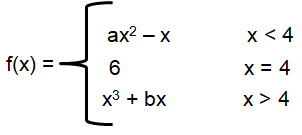
Solution :
|
(1) = (3) 16a - 4 = 6 16a = 6 + 4 16a = 10 a = 10/16 a = 5/8 |
(2) = (3) 64 + 4b = 6 4b = 6 - 64 4b = -58 b = -58/4 b = -29/2 |
Problem 5 :
Find the values of a and b, if the function is continuous for all x.
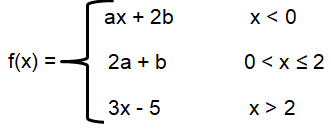
Solution :
(1) = (2)
2b = 2a + b
2b - b = 2a
b = 2a
(3) = (4)
2a + b = 1
Applying the value of b here, we get
2a + 2a = 1
4a = 1
a = 1/4
Applying the value of a in b = 2a
b = 2(1/4)
b = 1/2
Recent Articles
-
Finding Range of Values Inequality Problems
May 21, 24 08:51 PM
Finding Range of Values Inequality Problems -
Solving Two Step Inequality Word Problems
May 21, 24 08:51 AM
Solving Two Step Inequality Word Problems -
Exponential Function Context and Data Modeling
May 20, 24 10:45 PM
Exponential Function Context and Data Modeling